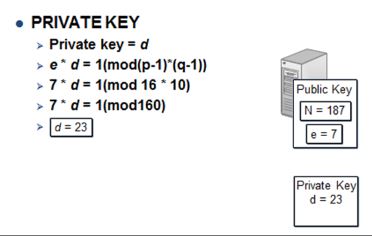A Public-Key Encryption Example
The following steps show how to perform public-key encryption:
- Generating the public key,
- Using the public key to generate the private key,
- Encrypting the text into ciphertext, and
- Decrypting the ciphertext into the original text.
Generating the Public Key
|
First, pick two random giant prime numbers.
This example picks two small primes to keep it simple: 17 and 11.
Multiply them to get 17×11 = 187.
Pick another prime: 7.
That is our public key including two numbers, 187 and 7.
|
|

|
Pick p = 17 and q = 11
⇒ p×q = 17×11 = 187 = N
⇒ Public key is (N=187, e=7)
Generating the Private Key
Pick an algorithm, modular arithmetic in this example, to generate the private key from the public key.
One of the modular arithmetic examples is 38 = 2 (mod 12) because 38–2 = 36, which is a multiple of 12.
|
|

|
e × d = 1 ( mod (p–1)×(q–1) ), the algorithm used
= 7 × d = 1 ( mod (17–1)×(11–1) ) ∵ e=7, p=17, q=11
= 7 × d = 1 ( mod 16×10 )
= 7 × d = 1 ( mod 160 )
⇒ Private key d = 23

